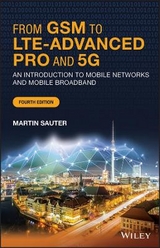
From GSM to LTE–Advanced Pro and 5G
Wiley-Blackwell (an imprint of John Wiley & Sons Ltd) (Verlag)
978-1-119-34686-9 (ISBN)
- Titel erscheint in neuer Auflage
- Artikel merken
A comparative introduction to major global wireless standards, technologies and their applications From GSM to LTE-Advanced Pro and 5G: An Introduction to Mobile Networks and Mobile Broadband, 3rd Edition provides technical descriptions of the various wireless technologies currently in use. It explains the rationales behind their differing mechanisms and implementations while exploring the advantages and limitations of each technology. This edition has been fully updated and substantially expanded to reflect the significant evolution in mobile network technology occurring over the past several years. The chapter on LTE has been extensively enhanced with new coverage of current implementations of LTE carrier aggregation, mobility management, cell reselection and handover procedures, as well as the latest developments in 5G radio and core networks in 3GPP. It now features additional information on the TD-LTE air interface, IPv6 in mobile networks, Network Function Virtualization (NFV) and Narrowband Internet of Things (NB-IOT).
Voice-over-LTE (VoLTE) is now treated extensively in a separate chapter featuring coverage of the VoLTE call establishment process, dedicated bearer setup, header compression, speech codec and bandwidth negotiation, supplementary service configuration and VoLTE emergency calls. In addition, extensive coverage of Voice-over-Wifi and mission critical communication for public safety organizations over LTE has been added. The WLAN chapter now provides coverage of WPA2-Professional with certificates for authentication in large deployments, such as the global Eduroam network and the new WLAN 60 GHz air interface. Bluetooth evolution has been addressed by including a detailed description of Bluetooth Low Energy (BLE) in the chapter devoted to Bluetooth. * Describes the different systems based on the standards, their practical implementation and design assumptions, and the performance and capacity of each system in practice is analyzed and explained * Questions at the end of each chapter and answers on the accompanying website make this book ideal for self-study or as course material.
Martin Sauter works in the telecommunication industry as a thought leader, researcher, book author and blogger and is based in Cologne. His interests are focused on mobile communication networks, multimedia applications and especially the wireless Internet. http://www.wirelessmoves.com
Preface and Overview Chapter 1: GSM 1.1 Circuit Switched Data transmission 1.2 Standards 1.3 Transmission Speeds 1.4 The Signaling System Number 7 1.5 The GSM Subsystems 1.6 The Network Subsystem 1.7 The Base Station Subsystem (BSS) 1.8 Mobility Management and Call Control 1.9 The Mobile Station 1.10 The SIM card 1.11 The Intelligent Network Subsystem and CAMEL 1.12 Questions References Chapter 2: General Packet Radio Service (GPRS) and EDGE 2.1 Circuit Switched Data Transmission over GSM 2.2 Packet Switched Data Transmission over GPRS 2.3 The GPRS Air Interface 2.4 The GPRS State Model 2.5 GPRS Network Elements 2.5.1 The Packet Control Unit (PCU) 2.5.2 The Serving GPRS Support Node (SGSN) 2.5.3 The Gateway GPRS Support Node (GGSN) 2.6 GPRS Radio Resource Management 2.7 GPRS Interfaces 2.8 GPRS Mobility Management and Session Management (GMM/SM) 2.13 Questions References Chapter 3: UMTS & HSPA 3.1 Overview, History and Future 3.2 Important New Concepts of UMTS Release 99 3.3 Code Division Multiple Access (CDMA) 3.4 UMTS Channel Structure on the Air Interface 3.5 The UMTS Terrestrial Radio Access Network (UTRAN) 3.6 Core Network Mobility Management 3.7 Radio Network Mobility Management 3.8 UMTS CS and PS Call Establishment 3.9 UMTS Security 3.10 High Speed Downlink Packet Access (HSDPA) and HSPA+ 3.11 High Speed Uplink Packet Access (HSUPA) 3.12 Radio and Core Network Enhancements: CPC and One Tunnel 3.14 HSPA Performance in Practice 3.15 eCall 3.16 UMTS and CDMA2000 3.17 Questions References Chapter 4: From LTE to LTE-Advanced Pro 4.1 Introduction 4.2 Network Architecture and Interfaces 4.3 FDD Air Interface and Radio Network 4.4 TDD-LTE Air Interface 4.5 Scheduling 4.6 Basic Procedures 4.7 Mobility Management and Power Optimization 4.8 LTE Security Architecture 4.9 Interconnection with UMTS and GSM 4.10 Interworking with CDMA 2000 networks 4.11 Carrier Aggregation 4.12 Network Planning Aspects 4.13 CS-Fallback for Voice and SMS with LTE 4.14 Voice in Combined LTE and CDMA 2000 Networks (SV-LTE) 4.15 Network Sharing ? MORAN and MOCN 4.16 From Dipoles to Active Antennas and Gigabit Backhaul 4.17 IPv6 in Mobile Networks 4.18 Network Function Virtualization 4.19 Machine Type Communication and the Internet of Things 4.20 Other Features of LTE-Advanced and LTE-Advanced Pro 4.21 From LTE to 5G 4.22 Questions References Chapter 5: VoLTE, VoWifi and Mission Critical Communication 5.1 Overview 5.2 The Session Initiation Protocl (SIP) 5.3 The IP Multimedia Subsystem (IMS) and VoLTE 5.4 VoLTE Roaming 5.5 Voice over Wifi (VoWifi) 5.6 VoLTE compared to Fixed Line IMS in practice 5.7 Mission Critical Communication (MCC) 5.8 Questions References Chapter 6: WLAN 6.1 Wireless LAN Overview 6.2 Transmission Speeds and Standards 6.3 Wireless LAN Configurations: From Ad-hoc to Wireless Bridging 6.4 Management Operations 6.5 The MAC Layer 6.6 The Physical Layer and MAC Extensions 6.7 Wireless LAN Security 6.8 IEEE 802.11e and WMM ? Quality of Service 6.9 Questions References Chapter 7: Bluetooth 7.1 Overview and Applications 7.2 Physical Properties [additions for new Bluetooth versions] 7.3 Piconets and the Master/Slave Concept 7.4 The Bluetooth Protocol Stack 7.5 Bluetooth Security 7.6 Bluetooth Profiles 7.7 Bluetooth Low Energy 7.8 Questions References
| Erscheinungsdatum | 13.06.2018 |
|---|---|
| Verlagsort | Chicester |
| Sprache | englisch |
| Maße | 171 x 252 mm |
| Gewicht | 1054 g |
| Themenwelt | Technik ► Elektrotechnik / Energietechnik |
| Technik ► Nachrichtentechnik | |
| ISBN-10 | 1-119-34686-X / 111934686X |
| ISBN-13 | 978-1-119-34686-9 / 9781119346869 |
| Zustand | Neuware |
| Haben Sie eine Frage zum Produkt? |
aus dem Bereich



